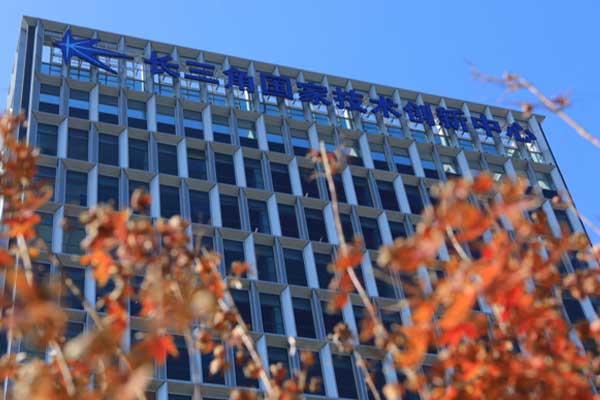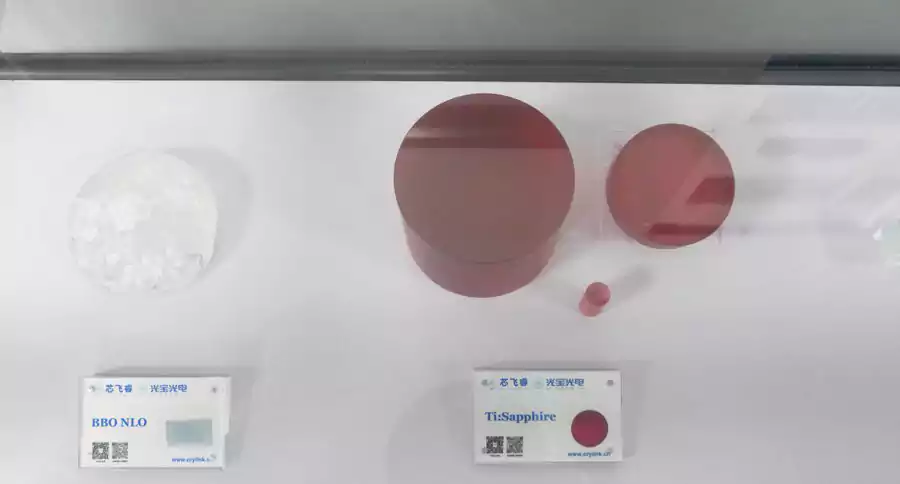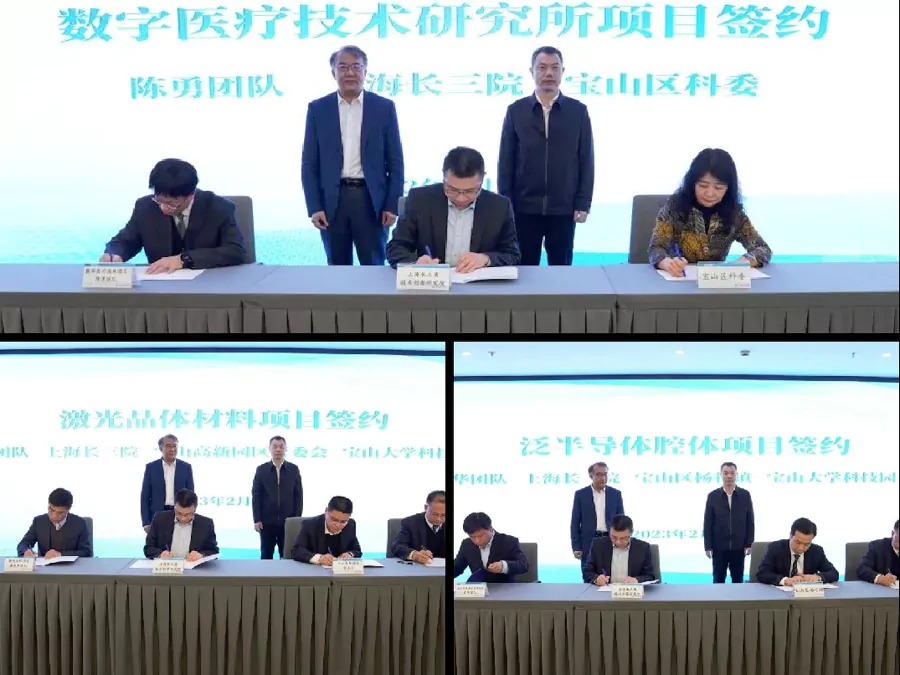This article is quoted from “Shanghai Observer”, click this link to view the original text.

At the beginning of this year, Dr. Dong Yongjun returned to Shanghai after many years of absence and became the chairman of Shanghai Crylink Technology Co., LTD. In 2014, this scientist who worked at the Shanghai Institute of Optics and Precision Mechanics of the Chinese Academy of Sciences went to Nanjing Crylink Technology Co., Ltd. to develop laser crystal materials and other products. The reason why he returned to Shanghai to start his own business for the second time was that the Yangtze River Delta National Technology Innovation Center hired him as a project manager, responsible for the implementation of the “Laser Crystal Materials” project. The unit that implements this cutting-edge technology industrialization project is Crylink Company.
This start-up company settled in Baoshan District is a beneficiary of the “invest first, share later” reform pilot. According to the reform plan, Xinfeirui’s scientific research and management team holds 90% of the shares, and the Shanghai Yangtze River Delta Technology Innovation Research Institute’s shareholding platform holds 10%; Shanghai Changsan Institute and Shanghai Baoshan Technology Transfer Co., Ltd. will establish a 1:1 agreement within two years. The funds are matched, each investing 15 million yuan to support the company’s industrialization research, and retaining stock conversion options.
The so-called “invest first, share later” refers to the investment of financial funds into scientific and technological enterprises in the form of scientific research project support. After the enterprise completes its scientific research tasks and obtains social financing, the initial investment is converted into equity. This reform is conducive to promoting the transformation of leading technological achievements and cultivating a “whole-process innovation” ecosystem.
14 “ALLOCATION & INVESTMENT” projects were launched in Shanghai
Luo Dajin, director of the Shanghai Municipal Science and Technology Commission, said that strengthening “whole-process innovation” refers to focusing on the entire process of basic research, applied basic research and industrialization, improving the source function and systematization capabilities of scientific and technological innovation, strengthening the main position of enterprises in scientific and technological innovation, and focusing on card-oriented Neck fields and industry needs, promote a number of key core technologies and underlying technology breakthroughs, and achieve high-level technological self-reliance and self-reliance.
“Our goal of promoting scientific and technological innovation can be expressed in three ‘wholes’.” Luo Dajin said that in order to continue to strengthen “whole-process innovation”, we must also promote “whole-chain acceleration” and stimulate “whole-of-society vitality”, that is, deepen Reform the science and technology system and mechanism, grasp the laws of innovation in different technical fields and stages, gather superior international and domestic innovation resources, strengthen top-level design, and promote the deep integration of the innovation chain, industrial chain, capital chain, and talent chain; at the same time, create high-level scientific and technological innovation talents Highlands, optimize the scientific and technological talent introduction and education system, cultivate and gather global scientific and technological leaders, accelerate the formation of innovative resource optimization methods that scientists dare to work, capital dares to invest, enterprises dare to venture, and the government dares to support, and create a passionate, selfless, dare to venture and dare to fight. innovation culture.
The Yangtze River Delta National Innovation Center, unveiled in June 2021 and headquartered in Zhangjiang Science City, is a national innovation platform organized and constructed by the central government and the three provinces and one city in the Yangtze River Delta. As a new R&D institution leading the construction of the Yangtze River Delta National Innovation Center, Shanghai Changsan Research Institute plays an important role in strengthening “whole-process innovation” and promoting “whole-chain acceleration”.

In February this year, the Yangtze River Delta National Innovation Center and the Baoshan District Party Committee and District Government jointly held a cooperation project signing conference to implement the “laser crystal materials” and “pan-semiconductor vacuum cavity” models using the “pre-investment convertible equity” and “ALLOCATION & INVESTMENT” models. A major industrialization technology project, and jointly established a digital medical technology research institute.
Today, Shanghai Changsan Hospital has launched 14 “ALLOCATION & INVESTMENT” projects, 7 of which are in Baoshan District, accounting for 50%. Yang Hui, director of the Science and Technology Commission of Baoshan District, introduced that in 2021, Baoshan District successfully unveiled the national innovation reform pilot task of the National Development and Reform Commission and the Ministry of Science and Technology of “promoting the transformation of scientific and technological achievements through investment first and equity later”. At present, a standardized work system has been formed, a set of evaluation indicators for achievement transformation have been established, and a joint support project path of “ALLOCATION & INVESTMENT” with the Yangtze River Delta National Innovation Center has been established to explore a sustainable “government guidance + market” “Relay” financial support model.
Yangtze River Delta linkage breaks through laser core technology
“With the laboratory construction and production base gradually put into use, we plan to launch market financing next month.” Dr. Dong Yongjun told reporters. Through “pre-investment convertible equity” with financial funds, a new generation of integrated laser materials and miniaturized laser device headquarters and production base with a total investment of 100 million yuan have been basically completed, including a laser crystal material finishing production line, a laser crystal material integrated production line and Laser device packaging production line.
At Crylink Company, the reporter saw a number of high-end equipment such as optical coating machines and precision polishing machines, as well as laser crystals of different colors and shapes. Crystals are solids composed of atoms, ions, molecules and other microscopic substances arranged in a certain spatial order. They have regular shapes. Gemstones and crystals are naturally formed crystals. As a material for solid lasers, laser crystals are grown in an artificial environment, requiring near-perfect atomic arrangement and a high technical threshold.

For a long time, high-end laser crystal materials and device processes have been monopolized by some foreign companies, which has restricted the development of my country’s laser industry. In order to solve this pain point, Dong Yongjun embarked on the road of entrepreneurship and became a “cross-border” scientist working at the Chinese Academy of Sciences and enterprises. After years of technical research, he led the team to master a variety of laser crystal material growth technologies such as the pull-up method, the descent method and the flux method, and developed a lossless integration technology suitable for different crystal materials, overcoming the difficulties in heat dissipation and complex adjustment of solid lasers. , low reliability and other industrial bottlenecks, and developed a series of integrated laser crystal products.
Entering Crylink’s laboratory, Gao Peng, secretary of the company’s board of directors, showed reporters a miniaturized laser device. It is only about the size of a 50-cent coin, but it integrates three different laser crystal materials. “The integration technology our company has mastered can enable devices to have the functions of a variety of laser crystals.”
After settling in Shanghai, Shanghai Crylink formed a linkage relationship with Nanjing Crylink in the Yangtze River Delta – Shanghai Crylink is positioned as the corporate headquarters and R&D center. As a subsidiary of Shanghai Crylink, Nanjing Crylink is responsible for the mass production of most products.
Soon, Dong Yongjun tasted the sweetness of settling in Shanghai: “Shanghai universities and scientific research institutes are strong and can efficiently carry out industry-university-research cooperation and attract more high-level talents. We have recruited more than 20 R&D personnel in related professions. .” According to reports, Crylink has established in-depth cooperative relationships with the Shanghai Institute of Optics and Mechanics of the Chinese Academy of Sciences, Tongji University, and the University of Shanghai for Science and Technology to jointly carry out product research and development and talent training of laser crystals and devices.
Banks set up “pre-investment convertible equity cluster loans”
Tan Ruicong, deputy director of the Yangtze River Delta National Innovation Center and secretary of the Party Committee of the Shanghai Yangtze River Delta Technology Innovation Research Institute, said that in order to strengthen “whole process innovation”, the Yangtze River Delta National Innovation Center is working hard to improve the “full chain acceleration” mechanism and continue to improve the systematization of scientific and technological innovation. capabilities, work with Jiangsu, Zhejiang and Anhui to deepen regional innovation synergy in the Yangtze River Delta, jointly build a scientific and technological innovation community, jointly open up new areas and new tracks for development, and create new momentum and new advantages for development.
Crylink and other 14 hard technology companies were able to land in Shanghai, which originated from the “ALLOCATION & INVESTMENT” reform exploration of the Yangtze River Delta National Innovation Center. This is an innovative measure taken by the center to support the transformation and industrialization of leading and disruptive technologies. “We focus on a type of technology that has high risks in the early stages of the technological frontier and has failed market investment judgments, but may have a disruptive impact on future industries and is expected to fill domestic gaps. Combined with the needs of local industrial transformation and upgrading and the cultivation direction of new fields and new tracks, we Select a team of first-class technical leaders from around the world, cultivate and establish a project company in which the core team has absolute control, and use financial funds to support the project company in the form of R&D projects to accelerate technology maturation, complete process verification and commercial-level product development.” Tan Ruicong introduced that when the company completes R&D When we complete the task and obtain social financing, we will convert the funds invested in the early stage into the company’s equity according to the market valuation, and manage or exit according to the market-oriented method; if the company does not obtain financing after completing the research and development task, it will be evaluated and accepted according to the project, and Retain the right to transform project results and tolerate project “failure”.

This year, the Yangtze River Delta National Innovation Center’s “ALLOCATION & INVESTMENT” and Baoshan District’s “pre-investment convertible equity” reform pilot achieved organic connection. After project research and judgment, the Yangtze River Delta National Innovation Center recommended industrialization projects to Baoshan District that were in line with the leading industry direction of Baoshan District and planned to be supported by “ALLOCATION & INVESTMENT”. After consultation with multiple departments in Baoshan District, the district government opened a green channel and directly adopted it. The “ALLOCATION & INVESTMENT + pre-investment convertible equity” jointly supports the implementation of project companies. At the same time, experts from the Yangtze River Delta National Innovation Center also participated in the selection and review of Baoshan District’s “pre-investment convertible equity” projects, and provided joint support to the projects that were unanimously optimistic about them.
Strengthening “whole-process innovation” is also reflected in all-round support for project companies after their establishment. Zhu Jinghong, general manager of Shanghai Baoshan University Science and Technology Park Development Co., Ltd., said that in terms of debt, this state-owned enterprise has secured more than 20 million yuan in credit for Baoshan’s “pre-investment convertible equity” project in response to the liquidity problems faced by start-up technology companies. , and promoted the Shanghai Branch of China Construction Bank to specifically set up “pre-investment convertible equity cluster loans”, with a total amount of 150 million yuan; in terms of application scenarios, it has successfully connected upstream and downstream customers for the first batch of “pre-investment convertible equity” projects, accumulating intended orders The amount exceeds 30 million yuan.
As a beneficiary of the “whole-process innovation” service, Crylink has applied for loans from many banks such as China Construction Bank and Bank of Communications, and purchased a high-end optical coating machine sold by a Baoshan company. “The Yangtze River Delta National Innovation Center and various departments in Baoshan District have dedicated personnel and dedicated teams to connect with each other to provide us with considerate services, including policy support, resource docking, talent recruitment and settlement, allowing Xinfeirui to grow rapidly.” Gao Peng told reporters.
Lay out and build a number of new R&D institutions
This year, the Shanghai Municipal Government and various districts launched a series of policies and initiatives to strengthen “whole-process innovation.” Taking the new “embodied intelligence” track triggered by the ChatGPT large model as an example, the Shanghai General Robot Industry Research Institute was recently established. Under the guidance of the Municipal Economic and Information Technology Commission and the Municipal Science and Technology Commission, this institute is a new research and development institution led by the Shanghai Artificial Intelligence Research Institute, jointly launched by Lingang Group, Zhiyuan Robot Company, etc., and is committed to promoting universal scenarios as a guide. Industrialization and large-scale application of innovative intelligent robot technologies and products.
As one of the initiators of this research institute, Zhiyuan Robot was founded by Internet celebrity “Zhihui Jun” and others. In August this year, it released the company’s independently developed humanoid robot prototype “Yuanzheng A1” in Shanghai. It is 1.75 meters tall and weighs 53 kilograms. It has 49 degrees of freedom throughout its body, that is, it is equipped with 49 electric joints and has a peak torque of 300 N·m. A large model is deployed in its body, which can understand natural language instructions and analyze the speaker’s intention. For example, if the owner says “I want a glass of water” or “I’m thirsty”, it will understand it, go to the water dispenser to get water, and then hand the water cup to the owner.
Song Haitao, president of the Shanghai Institute of Artificial Intelligence, believes that with the advent of ChatGPT, the integration of large models and robots will create a universal robot that is no longer limited to a certain application scenario. This kind of robot is a carrier for realizing “embodied intelligence” and is of strategic significance to the development of cutting-edge technology and industry. To this end, several units jointly initiated the establishment of the Shanghai General Robot Industry Research Institute, which will carry out six aspects of business including think tank consulting services, common technology research and development, achievement incubation and transformation, application innovation demonstration, industry fund and investment and financing analysis, and open exchange and cooperation. The entire process will cultivate innovative technologies and industrial development in this frontier field.
It is worth mentioning that Shanghai General Robot Industry Research Institute, Shanghai Artificial Intelligence Research Institute, and Shanghai Yangtze River Delta Technology Innovation Research Institute are all new R&D institutions that Shanghai has laid out and built in recent years, playing a key platform role in “whole-process innovation” . In May this year, the General Office of the Shanghai Municipal Party Committee and the Municipal Government issued the “Opinions on Promoting the High-Quality Development of New R&D Institutions in Our City”, proposing to focus on cultivating a group of strategic scientific and technological forces, extensively guiding social forces to participate in the construction of new R&D institutions, and striving to form The development pattern of complementary advantages and win-win cooperation between various R&D institutions provides strong support for strengthening the source function of scientific and technological innovation.

Frank
Frank graduated from the University of Shanghai for Science and Technology, majoring in optics. As a technical engineer at Crylink Company, he deeply understands crystal materials and laser components.
Related Video(s) with this Article
Related Product(s) with this Article
Related Application(s) with this Article
